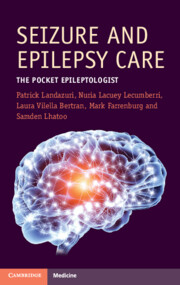Book contents
- Seizure and Epilepsy Care
- Seizure and Epilepsy Care
- Copyright page
- Contents
- 1 How Do I Evaluate a First-Time Seizure?
- 2 How Do I Make an Epilepsy Diagnosis?
- 3 Which Antiseizure Medicines Treat Epilepsy and How Do I Pick?
- 4 How Can I Best Use EEG for Treating Epilepsy Patients?
- 5 What Are Common Epilepsy Imaging Findings in New Onset and Chronic Epilepsy Care?
- 6 How Do I Care for Patients in the Emergency Department and Inpatient Settings?
- 7 How Do I Manage Epilepsy Emergencies Like Status Epilepticus?
- 8 What Is the Best Long-Term Treatment Plan for Epilepsy Patients as an Outpatient?
- 9 What to Do When Your Patient Fails Two Antiseizure Medicines
- 10 Nonepileptic Events and General Psychiatric Care for Epilepsy Patients
- 11 What Are Essential Pediatric Epilepsy Clinical Diagnoses and Treatment Plans?
- Index
- References
1 - How Do I Evaluate a First-Time Seizure?
Published online by Cambridge University Press: 28 January 2023
- Seizure and Epilepsy Care
- Seizure and Epilepsy Care
- Copyright page
- Contents
- 1 How Do I Evaluate a First-Time Seizure?
- 2 How Do I Make an Epilepsy Diagnosis?
- 3 Which Antiseizure Medicines Treat Epilepsy and How Do I Pick?
- 4 How Can I Best Use EEG for Treating Epilepsy Patients?
- 5 What Are Common Epilepsy Imaging Findings in New Onset and Chronic Epilepsy Care?
- 6 How Do I Care for Patients in the Emergency Department and Inpatient Settings?
- 7 How Do I Manage Epilepsy Emergencies Like Status Epilepticus?
- 8 What Is the Best Long-Term Treatment Plan for Epilepsy Patients as an Outpatient?
- 9 What to Do When Your Patient Fails Two Antiseizure Medicines
- 10 Nonepileptic Events and General Psychiatric Care for Epilepsy Patients
- 11 What Are Essential Pediatric Epilepsy Clinical Diagnoses and Treatment Plans?
- Index
- References
Summary
First-time seizures are a common part of neurology practice. Making an accurate and specific diagnosis is achievable by taking an excellent history. Clinicians should keep in mind that seizures are only part of the differential in a patient with a first-time event, with other diagnoses like syncope common as well. This history should focus on what the seizure feels like to the patient and looks like to observers. Two classification systems, the seizure semiology and International League Against Epilepsy (ILAE), exist to make communicating complex information easier. Key semiology history includes the presence or absence of auras, altered awareness, or convulsions. In addition to history, laboratory, EEG, and imaging data can inform to the specific patient diagnosis. If you determine that the patient has had a first-time seizure without a clear epilepsy diagnosis, you can tell them seizure that the recurrence risk is 40%. If you determine the patient has epilepsy, you can tell them that 50% of people are seizure-free with the first medication used. Patients should be reassured that they can live normal lives with most jobs being obtainable and family life being a possibility if the patient so chooses.
- Type
- Chapter
- Information
- Seizure and Epilepsy CareThe Pocket Epileptologist, pp. 1 - 22Publisher: Cambridge University PressPrint publication year: 2023

